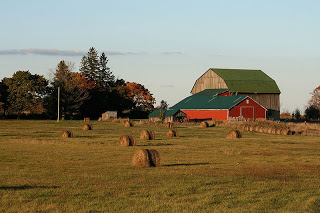 |
| WIki Image |
Taylor Reid
BeginningFarmers
House Republicans Propose Slashing Local Food, Rural Development, Child Nutrition, and Conservation Programs
On May 31st 2011 the House Appropriations Committee approved its fiscal year 2012 Agricultural Appropriations bill (to read the full text of the bill CLICK HERE) with major cuts in agricultural program spending – a 13.4% reduction in from fiscal year 2011. What is most worrisome is where the cuts have come. While the proposed bill actually increases Commodity Crop Payments by $150 million, it seems to take specific aim at much smaller programs funding local food, rural development, child nutrution, conservation, sustainable agriculture (SARE) and fair competition rules for meat producers.
An Attack on Local Food Systems
The House Appropriations Committee Report suggests that efforts to promote local and regional food systems are unnecessary and wasteful in a number of ways. In reality, local food systems have the potential to dramatically increase farmers share of the food dollar, and stimulate economic development and job creation by encouraging local reinvestment rather than corporate profit. The House Committee’s explicit attack on local and regional food systems is one of the most striking elements of the bill’s text, and that of the Committee Report.
With regard to research, the Report explicitly states that: “While the Committee appreciates the work of the dedicated staff of NIFA [National Institute of Food and Agriculture], especially for their efforts to reorganize the agency and raise the profile of agricultural research as directed by the Food, Conservation, and Energy Act of 2008, it is concerned about some of the research being funded by the agency. For example, the agency recently awarded more than $23 million in grants to improve regional and local food systems. Over the past few years, numerous reports from Federal agencies and private philanthropic and scientific organizations have highlighted the need for the United States to invest in agricultural research, particularly to ensure productivity growth and to develop and refine sound natural resources management practices for U.S. farmers and ranchers and others around the world. In light of this advice and the nation’s serious budget deficit and debt problems, the agency should be focusing its research efforts on only the highest priority, scientifically merited research. While there are many interesting research topics and a multitude of issues that could be researched, the Committee expects the agency to focus on its core mission of agricultural research by setting a very high standard for research funded by the agency and requiring a rigorous peer review.” (Republican Appropriations Full Committee Report page 14).
While recognizing the need to control spending and deal with the budget deficit, it is difficult for me to understand how “improving local and regional food systems” with $23 million of the $700 million dollars spent on research (about 3 percent) either fails to fulfill the goal of developing “sound natural resources management practices” (if developing local food systems don’t do this, I’m not sure what does) or significantly addresses “the nation’s serious budget deficit and debt problems”.
The Committee Report also singles out USDA’s Know Your Farmer, Know Your Food initiative which focuses on building local and regional food systems, strengthening rural communities, promoting healthy eating, and protecting natural resources. Though the Committee lacks the power to cut such a program, the report implicitly demeans the initiative and explicitly adds new requirements stating: “The Committee directs the Department to provide an electronic notification to the Committee at least 72 hours prior to any travel in support of the ‘Know Your Farmer-Know Your Food’ initiative, and such notification shall include the agenda for the entire trip along with the cost to U.S. taxpayers. Additionally, the Committee directs the Department to post Media Advisories of all such trips on its website, and that such advisories include the same information” (Page 5).
Defunding Rural Development Initiatives
The Report also declines to fund the Rural Innovation Initiative, stating: “The fiscal year 2012 budget request reproposed a Regional Innovation Initiative. Secretary Vilsack has said the purpose of the initiative is to take a different direction in rural development based on five pillars: rural broadband, biofuels and biobased products, linking local production with local consumption of farm products, ecosystem markets to pay farmers for storing carbon, and forest restoration and private land conservation. The Committee is unable to provide any funding or authorization for the initiative as requests for additional information on the specific purpose, need, and plans for the initiative have gone unanswered” (page 33). The details of the “requests for additional information” and the reasons that they “have gone unanswered” are not something I have no specific knowledge of. But this appears to be simply another excuse to cut funding for local food system development among other things. Beyond this, according to a report from the National Sustainable Agriculture Coalition “The bill cuts the Value Added Producer Grants (VAPG) program to $12.5 million, nearly a quarter of its authorized level and nearly half of what went out the door in 2010. The bill would also completely eliminate the Rural Micro-entrepreneur Assistance Program (RMAP), including its farm bill mandatory funding of $3 million.”
Sorry Kids, Your Nutrition will Have to Wait
In addition, the Committee attacks the new nutrition requirements for school lunch and breakfast programs, the report states that:”The Committee notes that FNS [Food and Nutrition Service] has responded to the actions required by the Healthy, Hunger-Free Kids Act of 2010, P.L. 111–296. The Committee urges restraint and practical timelines for implementing new national nutrition standards in the school breakfast and lunch programs. As many of the representatives in states and local school districts have cautioned, an overly aggressive implementation schedule and unrealistic demands on changes in nutrient content can lead to burdensome costs, estimated to be about $7 billion over 5 years. Therefore, the Committee directs FNS to issue a new proposed rule that would not require an increase in the cost of providing school meals” (page 41-42). In other words, the Committee is proposing to defund the Healthy, Hunger Free Kids Act of 2010 by requiring that the rules be rewritten such that they avoid any increase in cost at a time when food prices are increasing significantly, and urging “restraint…for implementation”.
Slashing Conservation and Sustainable Agriculture, and Prohibiting Fair Competition Rules
Without going into depth, the bill would also make significant cuts in conservation programs, the Sustainable Agriculture Research and Education Program, and explicitly prohibits implementation of USDA rules for fair competition in the meat industry (GIPSA) For more information, see the NSAC Report.
What’s Next
A floor vote in the house seems likely to pass the proposed legislation with the aforementioned cuts largely intact. The Senate has yet to draft its own Ag. Appropriations Bill. Once it does, the two bills will need to be reconciled. We’ll be sure to keep you updated.
linkwithin_text=’Related Articles:’
GS_googleAddAdSenseService(“ca-pub-1897954795849722”);GS_googleEnableAllServices();
GA_googleAddSlot(“ca-pub-1897954795849722”, “Enerfood_Bonus”);
GA_googleFetchAds();
GA_googleFillSlot(“Enerfood_Bonus”);


Be the first to comment on "Slashing Local Food, Rural Development, Child Nutrition, and Conservation"